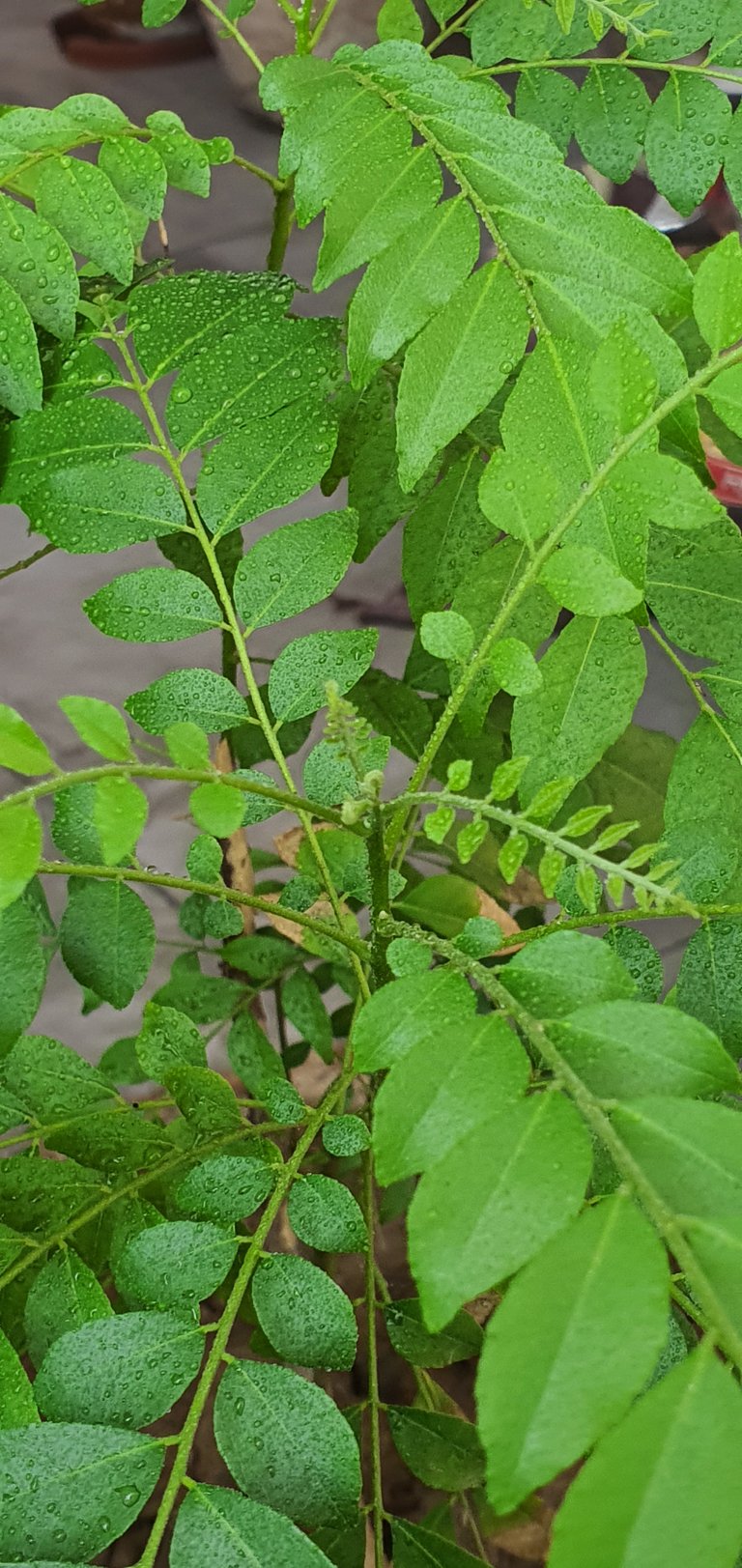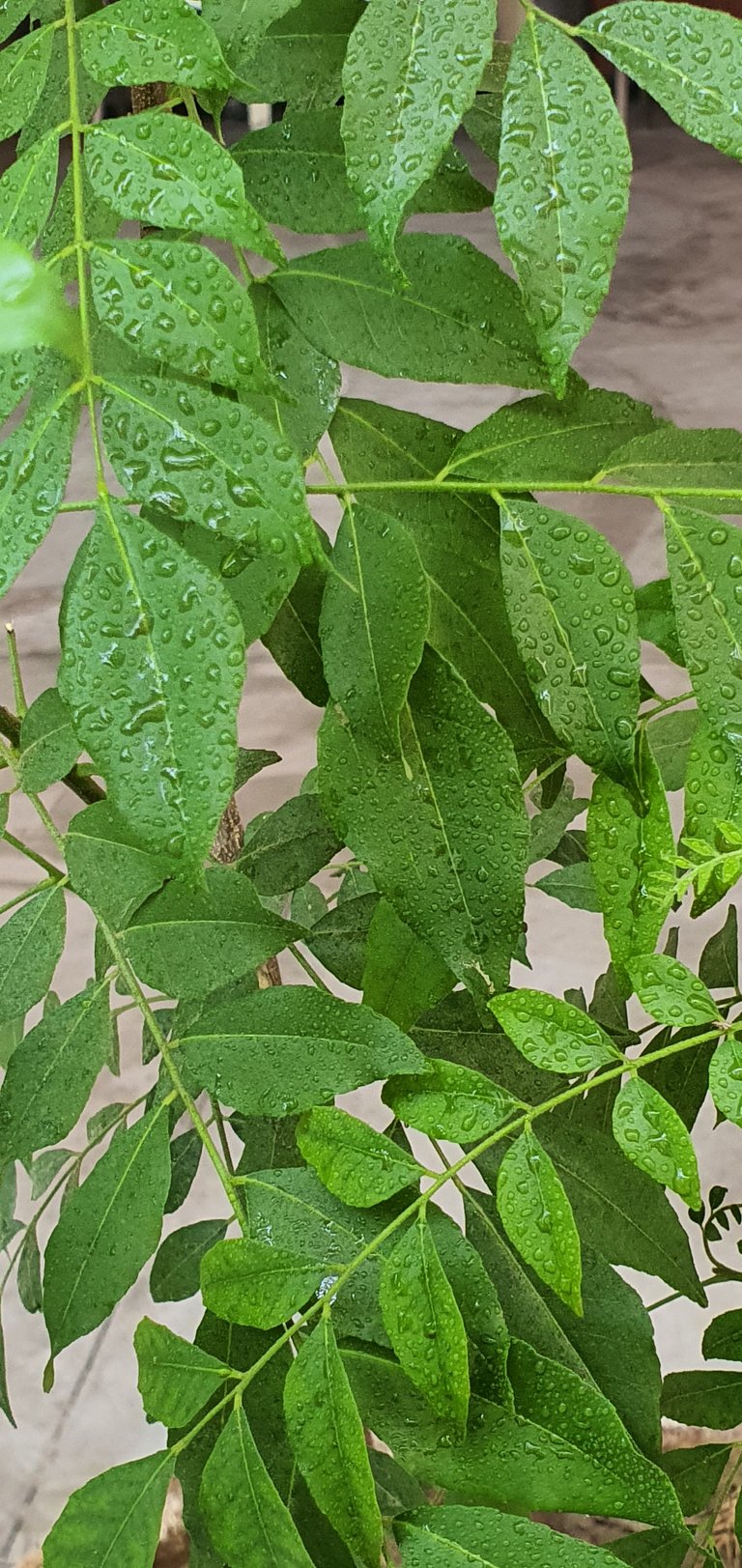Hello everyone, hope you're all doing well. This morning, as I was watering my plants, I noticed the tiny curry leaves (mithi neem) glistening with water, and they looked so beautiful that I thought today I'd talk about the benefits of curry leaves with you.


Curry leaves
Curry leaves, which are commonly used in Indian cooking to add flavor to dishes, are not just for decoration. They are packed with health benefits, can be used for cosmetic purposes, and have a unique taste that is familiar to people in India.
Curry leaves originally come from India, Sri Lanka, and Bangladesh and were brought to other places by Indian immigrants. Nowadays, they are grown all around the world. Just like mustard seeds and turmeric, these leaves are used regularly in the cooking of West and South India. So, curry leaves are a significant part of India's food culture.
In India, curry leaves have various names that often mean "sweet neem" because they resemble neem leaves. Some examples are "Kadi Patta" or "Meetha Neem" in Hindi, "Kariveppilai" in Tamil, and "Karivempu" in Malayalam.
Curry leaves can make basic curries and vegetables taste even better with just a little bit of frying. They have a captivating smell and a slightly bitter, but flavorful and sharp taste.
Curry powder is different from curry leaves. The leaves have a unique flavor that can't be replicated by any other plant or spice. The powder is a blend of spices, while the curry leaf is a herb.
In Indian cuisine, curry leaves are used in various ways:
Tadka: They are sautéed in ghee, vegetable oil, or coconut oil to bring out their unique flavor. This process, known as tadka or tempering, enhances the taste of dishes like dal, sabzi, sambhar, and chutney.
Use it to Garnish your dish: You can directly add curry leaves to your dish as a garnish. Dried leaves can also be used for garnishing, although they take longer to infuse flavor.
Curry leaves are used in making curries, soups, rice dishes, lentils, and chutneys. They pair well with coconut, coriander, and mint when making chutney.
Here are the key nutritional facts about curry leaves:
In every 100 grams of curry leaves, there are about 108 calories.
Curry leaves are rich in carbohydrates, providing energy to your body. They also contain dietary fiber, which is good for digestion.
These leaves are packed with important minerals like calcium, phosphorus, zinc, iron, potassium, and magnesium, all of which are good for your health.
Curry leaves have essential oils that give them their unique flavor.
They contain several vitamins, including Vitamin B1, Vitamin B2, Vitamin B3, Vitamin B9, Vitamin C, and Vitamin E.
Curry leaves also have antioxidants like Vitamin C, Chlorophyll, Zinc, Vitamin E, and Carotene, which help protect your body from damage.
Additionally, curry leaves are low in fat, with only 0.1 grams of fat per 100 grams.
Importance in Terms of Nutrition:
Fibre: Curry leaves contain fiber, which is good for your gut health and helps with regular bowel movements.
Protein: They are rich in protein, which is a crucial building block for your body.
Calcium: Curry leaves are high in calcium, which is essential for strong bones and teeth.
Phosphorus: They contain abundant phosphorus, which can help cleanse your kidneys and relieve muscle cramps.
Essential Oils: These leaves have many essential oils with various benefits. These oils have properties that are anti-diabetic, anti-inflammatory, and anti-bacterial. They also contribute to maintaining healthy hair, skin, and gums.
Health benefits of curry leaves:
Cholesterol Control: They can help lower cholesterol levels.
Detoxification: Curry leaves remove toxins from your body.
Oral Health: They keep your mouth healthy and freshen your breath.
Eye Health: Good for your eyes and can prevent eye issues.
Healing: Curry leaves aid in healing wounds and preventing infections.
Anemia Prevention: They help maintain healthy red blood cells.
Weight Loss: Useful for shedding extra weight.
Diabetes Management: Can help control blood sugar levels.
Anti-bacterial: Fight off infections in your body.
Liver Support: Beneficial for liver health.
Morning Sickness Relief: Can ease nausea during pregnancy.
Stress Reduction: Their aroma helps relax and reduce stress.
For Skin and Hair Care:
Skin Soothing: Mix curry leaves, turmeric, and curd into a paste. Apply to your skin to calm irritations, rashes, and enhance skin texture.
Healthy Hair: Combine curry leaves with coconut oil to improve the quality of your hair.
Stronger Hair: Create a paste using curry leaves and lemon juice to strengthen your hair roots.
To maintain the freshness of curry leaves:
Harvest the fresh leaves.
Discard any damaged ones.
Thoroughly wash them.
Dry them completely.
Place them in an airtight container or a sealed bag.
Store them in the freezer for long-lasting preservation.
You can also store fresh curry leaves in the fridge for about two weeks if needed.
Thankyou for reading my post.
Congratulations @chhavi! You have completed the following achievement on the Hive blockchain And have been rewarded with New badge(s)
Your next target is to reach 20 posts.
You can view your badges on your board and compare yourself to others in the Ranking
If you no longer want to receive notifications, reply to this comment with the word
STOPTo support your work, I also upvoted your post!
Check out our last posts:
Discord Server.This post has been manually curated by @bhattg from Indiaunited community. Join us on our
Do you know that you can earn a passive income by delegating to @indiaunited. We share more than 100 % of the curation rewards with the delegators in the form of IUC tokens. HP delegators and IUC token holders also get upto 20% additional vote weight.
Here are some handy links for delegations: 100HP, 250HP, 500HP, 1000HP.
100% of the rewards from this comment goes to the curator for their manual curation efforts. Please encourage the curator @bhattg by upvoting this comment and support the community by voting the posts made by @indiaunited.
Wow, I have reblogged this article because of the knowledge found in it. It's quite educative and permit me to ask:
Is this curry am seeing here same as the curry leaves here in Nigeria? Am asking because, outs differs from the one you displayed here.
Also, how can I use curry for healthy hair growth? Please, I need your sincere answer.